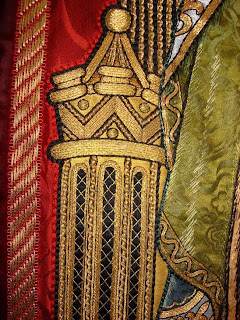I don't do much machine embroidery, and a real machine embroiderer like Michala at Kayla Coo should probably look away now, but it's fun to do for a change. As you may have gathered by now, most of my work is meticulously planned, so it's refreshing to do something freer. No marked up designs! No transfers! Not even any sketches - just make a start and see what happens.
 I then stiched another series of loops, rather closer together, over the top, using Sulky 1095. This then matched the back of the original bookmark.
I then stiched another series of loops, rather closer together, over the top, using Sulky 1095. This then matched the back of the original bookmark.
 The small patch of sewing at the top of the frame is a test piece, where I can make sure that what I'm planning will actually work before I have a go on the real thing. It also helps make sure I've got the sewing machine threaded up properly, and believe me, that's always worth testing!
The small patch of sewing at the top of the frame is a test piece, where I can make sure that what I'm planning will actually work before I have a go on the real thing. It also helps make sure I've got the sewing machine threaded up properly, and believe me, that's always worth testing!
I had a go at this bookmark a while ago, and I've never been happy with the front, though I quite liked the back. The front was trying to do too much - as well as machine embroidery it had appliqued silver kid and painted leather, and it was all too heavy for a small piece.
I decided to redo the front in a much simpler style, based on what I'd done previously for the back. Using silk satin I'd spaced dyed using Dylon Cold Bahama Blue and Turquoise Saga (if I can read my own handwriting - I wrote this down a while ago), with a piece of felt cut to shape on the back, I free-machined a series of loops along the length in Sulky 1090.
 I then stiched another series of loops, rather closer together, over the top, using Sulky 1095. This then matched the back of the original bookmark.
I then stiched another series of loops, rather closer together, over the top, using Sulky 1095. This then matched the back of the original bookmark. The small patch of sewing at the top of the frame is a test piece, where I can make sure that what I'm planning will actually work before I have a go on the real thing. It also helps make sure I've got the sewing machine threaded up properly, and believe me, that's always worth testing!
The small patch of sewing at the top of the frame is a test piece, where I can make sure that what I'm planning will actually work before I have a go on the real thing. It also helps make sure I've got the sewing machine threaded up properly, and believe me, that's always worth testing!When getting out the threads from the blue thread drawer (of course they're colour-coded!), I came across some dark turquoise lurex cord, so I laid that across the stiched loops, and couched it down using zig-zag stitch.
 I then finished it off with some small circles done in zig-zag stitch again, using Sulky 7001 (silver).
I then finished it off with some small circles done in zig-zag stitch again, using Sulky 7001 (silver). For the original version, I'd made some cords and little beaded tassles, which I've reused. They're mostly made from stranded cotton dyed at the same time as the fabric, but with a small amount of silver and some soft green in. The green went a lot better with the previous one than this, but never mind, it looks ok. I then ladder-stitched the two halves together and - here it is:
For the original version, I'd made some cords and little beaded tassles, which I've reused. They're mostly made from stranded cotton dyed at the same time as the fabric, but with a small amount of silver and some soft green in. The green went a lot better with the previous one than this, but never mind, it looks ok. I then ladder-stitched the two halves together and - here it is:



















